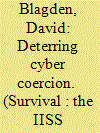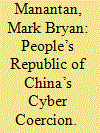| Srl | Item |
| 1 |
ID:
170581


|
|
|
|
|
| Summary/Abstract |
Even an anonymous belligerent cannot avoid identifying its interests, which those seeking deterrence can then hold at risk.
|
|
|
|
|
|
|
|
|
|
|
|
|
|
|
|
| 2 |
ID:
150089


|
|
|
|
|
| Summary/Abstract |
The use of coercive instruments of statecraft and military power to affect changes in strategic behavior is a common feature of international politics. Recently, a variety of state and sub-state actors have attempted to utilize cyber instruments of disruption and intrusion to bring about favorable outcomes. This article notes that digital instruments for coercion offer limited potential for effective compellent effect in world affairs. Nevertheless, as the case of North Korea's 2015 hack and (attempted) manipulation of Sony demonstrates, coercion using cyber weapons of intrusion and disruption is possible under particular conditions. In describing these conditions, I argue that the limits of cyber coercion should be seen more as a function of relevant social and institutional context than of the current state of technological possibilities. Technology certainly determines parameters of coercive interaction between actors, but success—and thus most determinants of strategic decisions surrounding cyber coercion—derives directly from sociopolitical context.
|
|
|
|
|
|
|
|
|
|
|
|
|
|
|
|
| 3 |
ID:
173990


|
|
|
|
|
| Summary/Abstract |
This paper investigates the increasing use of cyber coercion by the People’s Republic of China (PRC) among its core interests: Taiwan, Hong Kong, and the South China Sea. It argues that the PRC’s deployment of sophisticated attacks in the form of cyber coercion continues to be part of its geostrategic playbook to exert its influence and prosecute its wider interests as a rising power in the Indo-Pacific region. However, it observes that cyber coercion will be employed by the PRC in concert with all the other tools — diplomatic, economic, and the political — across the spectrum. The paper has two broad goals: first to unpack the trends or patterns in the PRC-sponsored cyber coercion by accentuating contextual and operational dimensions using Taiwan, Hong Kong, and the South China Sea as analytical case studies; second, to highlight the opportunities and limitations of using cyber coercion as an asymmetrical capability in the changing threat landscape. The paper concludes that the PRC’s cyber coercion is characterized by blurring the distinction on what constitutes compellence and deterrence. The boundaries are not clear cut, and to a certain degree both are even mutually reinforcing. The in-depth analysis of the case studies reveals the growing prominence of disinformation campaigns in close coordination with cyber operations (malware, phishing, and DDoS attack). This emboldens the PRC with a myriad of coercive strategies in shaping its external environment and realizing its ambition of national rejuvenation across Taiwan, Hong Kong, and the South China Sea.
|
|
|
|
|
|
|
|
|
|
|
|
|
|
|
|